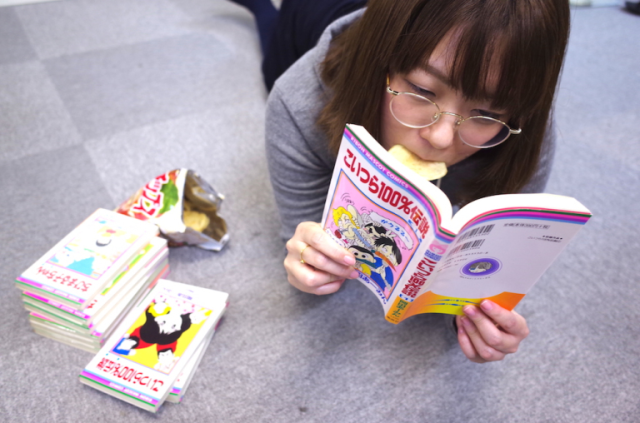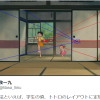
Turns out even physical media benefits from a free trial, one of Japan’s largest manga publishers learns.
If you’re a fan of Japanese comics, a stroll into the extensive manga section of bookstores in Japan can feel like heaven. Row after row of collected volumes, covering decades’ worth of content, all waiting for you to pick them up, leaf through their pages, and discover a new series to follow…oh, wait, scratch that last part.
See, Japanese bookstores almost universally shrink-wrap their collected manga volumes. Sometimes, there might be a single booklet printed on cheap paper with a half-dozen preview pages of one high-profile release, but aside from that, if you want to see what’s inside manga volumes in Japan, you’re going to have to buy the book before you even crack open the cover (and even some used manga shops have a similar policy).
The reason for the shrink-wrapping is pretty obvious. Publishers and retailers want to prevent what’s called tachiyomi, literally “standing reading,” where potential customers read through the content they’re interested in, then put it back on the shelf and walk out of the store without buying anything. But recently Shogakukan, one of Japan’s biggest manga publishers, has reversed its stance and begun asking retailers to not shrink-wrap certain manga.
▼ Though stores still draw the line at laying down on their floors and eating snacks.
Between March and May, Shagakkan requested that shrink-wrapping not be placed on either the first or most recent collected volumes of 35 titles it publishes. 36 stores participated in the test program, and when they tallied their sales for the period, they found that sales for shojo and josei manga (manga targeted towards girls and women) had jumped 20 percent for the period. Meanwhile, sales of shonen and seinen manga (oriented towards boys and men) stayed about the same, with no significant losses stemming from the relaxed tachiyomi policy. With a huge sales boost in half of its demographics and steady performance in the others, it’s safe to say the initiative was a success.
In hindsight, the sales increase makes a lot of sense. Before being published in collected volumes, manga run in serialized weekly or monthly anthologies, which were often read by train commuters on their way to or from work or school. But with more people whipping out their smartphones to kill time, even the online versions of those anthologies are competing with the rest of the Internet for attention, which raises the hurdle a manga series has to clear to capture a reader’s interest. Shogakukan says that by removing shrink-wrap from collected volumes, it thinks it can increase the potential for contact and familiarity among potential customers. with and the results of its pilot program, dubbed the Comics Shrink-wrapping Removal Project, seem to back up its hypothesis. These days, it can be hard enough just getting people to go to the trouble of going to a brick-and-mortar bookstore in the first place, and making those who do come feel welcome is paying off.
Another factor could be the dramatic shift in anime distribution that’s taken place over the last two decades. Shogakukan says its manga started being shrink-wrapped about 30 years ago, at a time when a large amount of anime was still being released in direct-to-video format. Today’s young fans, though, have grown up with the vast majority of anime being shown on for-free late-night television, which likely makes them much more averse to paying for content they haven’t sampled, and asking them to purchase collected volumes of a manga without giving them at least a free-of-charge look at the oldest and newest volumes is arguably asking too much.
Shogakkan says it’s also had success in boosting digital manga sales by providing expanded previews of the non-physical editions, and says it plans to continue easing access to its titles by expanding the Comics Shrink-wrapping Removal Project in the future.
Source: Asahi Digital Shimbun via Otakomu
Images ©SoraNews24
Follow Casey on Twitter, where he now wants to dig out his collected volumes of Maison Ikkoku.


 Reading manga before you buy now officially OK again at Japan’s biggest second-hand bookstore
Reading manga before you buy now officially OK again at Japan’s biggest second-hand bookstore Manga Art Hotel Tokyo welcomes foreign guests with over 5,000 manga, including English editions
Manga Art Hotel Tokyo welcomes foreign guests with over 5,000 manga, including English editions Survival horror manga “Holy Holy” delayed out of respect for Korean cruise ship accident
Survival horror manga “Holy Holy” delayed out of respect for Korean cruise ship accident “Umm… a little help?” Japanese Twitter user’s cat misjudges the size of potential new hangout
“Umm… a little help?” Japanese Twitter user’s cat misjudges the size of potential new hangout Animate Akihabara dispels misunderstanding that it will stop selling manga for adult men
Animate Akihabara dispels misunderstanding that it will stop selling manga for adult men McDonald’s new Happy Meals offer up cute and practical Sanrio lifestyle goods
McDonald’s new Happy Meals offer up cute and practical Sanrio lifestyle goods All-you-can-drink Starbucks and amazing views part of Tokyo’s new 170 meter-high sky lounge
All-you-can-drink Starbucks and amazing views part of Tokyo’s new 170 meter-high sky lounge Super Nintendo World expansion gets delayed for several months at Universal Studios Japan
Super Nintendo World expansion gets delayed for several months at Universal Studios Japan Studio Ghibli releases new action figures featuring Nausicaä of the Valley of the Wind characters
Studio Ghibli releases new action figures featuring Nausicaä of the Valley of the Wind characters Studio Ghibli glasses cases let anime characters keep an eye on your spectacles
Studio Ghibli glasses cases let anime characters keep an eye on your spectacles Beautiful Sailor Moon manhole cover coasters being given out for free by Tokyo tourist center
Beautiful Sailor Moon manhole cover coasters being given out for free by Tokyo tourist center McDonald’s Japan releases a pancake pie for new retro kissaten coffeeshop series
McDonald’s Japan releases a pancake pie for new retro kissaten coffeeshop series Kyoto’s 100 Demons yokai monster parade returns!
Kyoto’s 100 Demons yokai monster parade returns! Tokyo has a cafe lounge that’s for negative people only
Tokyo has a cafe lounge that’s for negative people only Manga artist raises question online about false perspective in Ghibli film My Neighbor Totoro
Manga artist raises question online about false perspective in Ghibli film My Neighbor Totoro Disney princesses get official manga makeovers for Manga Princess Cafe opening in Tokyo
Disney princesses get official manga makeovers for Manga Princess Cafe opening in Tokyo More foreign tourists than ever before in history visited Japan last month
More foreign tourists than ever before in history visited Japan last month Starbucks reopens at Shibuya Scramble Crossing with new look and design concept
Starbucks reopens at Shibuya Scramble Crossing with new look and design concept Beautiful new Final Fantasy T-shirt collection on the way from Uniqlo【Photos】
Beautiful new Final Fantasy T-shirt collection on the way from Uniqlo【Photos】 Is the new Shinkansen Train Desk ticket worth it?
Is the new Shinkansen Train Desk ticket worth it? Foreign English teachers in Japan pick their favorite Japanese-language phrases【Survey】
Foreign English teachers in Japan pick their favorite Japanese-language phrases【Survey】 Japanese convenience store packs a whole bento into an onigiri rice ball
Japanese convenience store packs a whole bento into an onigiri rice ball We try out “Chan Ramen”, an underground type of ramen popular in the ramen community
We try out “Chan Ramen”, an underground type of ramen popular in the ramen community Studio Ghibli releases Kiki’s Delivery Service chocolate cake pouches in Japan
Studio Ghibli releases Kiki’s Delivery Service chocolate cake pouches in Japan Japan’s bone-breaking and record-breaking roller coaster is permanently shutting down
Japan’s bone-breaking and record-breaking roller coaster is permanently shutting down New definition of “Japanese whiskey” goes into effect to prevent fakes from fooling overseas buyers
New definition of “Japanese whiskey” goes into effect to prevent fakes from fooling overseas buyers Our Japanese reporter visits Costco in the U.S., finds super American and very Japanese things
Our Japanese reporter visits Costco in the U.S., finds super American and very Japanese things Studio Ghibli unveils Mother’s Day gift set that captures the love in My Neighbour Totoro
Studio Ghibli unveils Mother’s Day gift set that captures the love in My Neighbour Totoro Foreign passenger shoves conductor on one of the last full runs for Japan’s Thunderbird train
Foreign passenger shoves conductor on one of the last full runs for Japan’s Thunderbird train Domino’s Japan now sells…pizza ears?
Domino’s Japan now sells…pizza ears? New Japanese KitKat flavour stars Sanrio characters, including Hello Kitty
New Japanese KitKat flavour stars Sanrio characters, including Hello Kitty Kyoto creates new for-tourist buses to address overtourism with higher prices, faster rides
Kyoto creates new for-tourist buses to address overtourism with higher prices, faster rides Sales of Japan’s most convenient train ticket/shopping payment cards suspended indefinitely
Sales of Japan’s most convenient train ticket/shopping payment cards suspended indefinitely Sold-out Studio Ghibli desktop humidifiers are back so Totoro can help you through the dry season
Sold-out Studio Ghibli desktop humidifiers are back so Totoro can help you through the dry season Japanese government to make first change to romanization spelling rules since the 1950s
Japanese government to make first change to romanization spelling rules since the 1950s Ghibli founders Toshio Suzuki and Hayao Miyazaki contribute to Japanese whisky Totoro label design
Ghibli founders Toshio Suzuki and Hayao Miyazaki contribute to Japanese whisky Totoro label design Doraemon found buried at sea as scene from 1993 anime becomes real life【Photos】
Doraemon found buried at sea as scene from 1993 anime becomes real life【Photos】 Tokyo’s most famous Starbucks is closed
Tokyo’s most famous Starbucks is closed One Piece characters’ nationalities revealed, but fans have mixed opinions
One Piece characters’ nationalities revealed, but fans have mixed opinions We asked a Uniqlo employee what four things we should buy and their suggestions didn’t disappoint
We asked a Uniqlo employee what four things we should buy and their suggestions didn’t disappoint Princesses, fruits, and blacksmiths: Study reveals the 30 most unusual family names in Japan
Princesses, fruits, and blacksmiths: Study reveals the 30 most unusual family names in Japan Japanese supermarket shrink-wraps a whole pig for hard-core pork fiends
Japanese supermarket shrink-wraps a whole pig for hard-core pork fiends Japanese manga artist shares his creative process for making a manga volume’s front cover
Japanese manga artist shares his creative process for making a manga volume’s front cover Death Note manga’s first new collected volume in 14 years announced
Death Note manga’s first new collected volume in 14 years announced Boys love posing book shows you how to draw two guys frolicking by that legendary pool!
Boys love posing book shows you how to draw two guys frolicking by that legendary pool! Critically acclaimed A-bomb manga Barefoot Gen excerpts removed from Hiroshima school curriculum
Critically acclaimed A-bomb manga Barefoot Gen excerpts removed from Hiroshima school curriculum 7-Eleven refuses to cooperate with municipal request to cover up its porno magazines in Japan
7-Eleven refuses to cooperate with municipal request to cover up its porno magazines in Japan Unemployed man and teen schoolgirl team up to steal manga, get arrested in Japan
Unemployed man and teen schoolgirl team up to steal manga, get arrested in Japan Do women who love manga have a harder time finding real-life romance?
Do women who love manga have a harder time finding real-life romance? Bookstore ad in Japan reminds us people with more money can buy more stuff
Bookstore ad in Japan reminds us people with more money can buy more stuff Titans attack Lawson convenience stores, bring tons of anime goodies with them
Titans attack Lawson convenience stores, bring tons of anime goodies with them Manga materials website offers thousands of reference poses for budding artists to download
Manga materials website offers thousands of reference poses for budding artists to download Genghis Khan-insulting manga pulled from major book stores amid further Mongolian protests
Genghis Khan-insulting manga pulled from major book stores amid further Mongolian protests Goku down! Vast majority of surveyed college students in Japan haven’t read the Dragon Ball manga
Goku down! Vast majority of surveyed college students in Japan haven’t read the Dragon Ball manga Tickets on sale for exhibit of every book Ghibli producer has ever read, boyhood room recreation
Tickets on sale for exhibit of every book Ghibli producer has ever read, boyhood room recreation
Leave a Reply